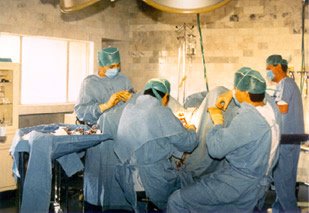Cosmetic Surgery Will Use Stem Cells
 Stem cell researchers have shown how cosmetic surgery, such as wrinkle removal and breast augmentation, might be improved with natural implants that keep their original size and shape better than synthetics.
Stem cell researchers have shown how cosmetic surgery, such as wrinkle removal and breast augmentation, might be improved with natural implants that keep their original size and shape better than synthetics.Stem cell researchers have shown how cosmetic surgery, such as wrinkle removal and breast augmentation, might be improved with natural implants that keep their original size and shape better than synthetics.
Cosmetic surgery might be performed with stem-cell generated natural tissues instead of synthetic implants. Saline and silicone implants for breast augmentation may rupture, leak, and interfere with breast cancer detection on mammograms. Stem cell generated natural tissue implants should avoid these problems.
Reconstructive surgery to replace tissues lost to cancer or other disease could benefit from stem-cell generated natural implants that do not shrink or lose their shape. Studies have shown that conventional soft tissue implants can lose 40 percent to 60 percent of their volume over time. Examples are breast tissue reconstruction after breast cancer surgery and facial soft tissue reconstruction following cancer or trauma surgeries.
Natural implants often require separate surgical procedures from a healthy location of the patient's body to obtain tissue for constructing the implant. The stem-cell approach does not require extensive surgery because cells needed for the implant are obtained in a less invasive needle procedure.
Whitaker investigator Jeremy Mao, Ph.D., of the University of Illinois at Chicago presented his results at the annual meeting of the American Association for the Advancement of Science in Washington, D.C., saying that a stem cell approach might eliminate the need for the additional surgery and may produce a long-lasting, shapely, and natural implant. The research will also be published in April in the journal Tissue Engineering.
Mao's research group started with a line of human stem cells taken from the bone marrow of a healthy, young volunteer. These mesenchymal stem cells can transform themselves into many different cell types under appropriate conditions, including those that form cartilage, bone, and fat. In this case, the stem cells were grown with substances that encouraged them to become fat-producing cells.
Cells from this culture were placed in a Food and Drug Administration-approved scaffold that mimics the natural environment in which fat cells grow in the body. The hydrogel scaffold can be molded into any shape or size. These cell seeded scaffolds were placed under the skin in eight laboratory mice. After four weeks, the implants were removed and examined.
The researchers found that the stem cells had differentiated into fat generating cells and the implant had retained both its original size and shape. Conventional implants begin to lose shape within a few weeks, so Mao's group was encouraged by the fact that their implants retained their original dimensions for a month.
These results demonstrate the potential of using such an approach in medical applications. But more, longer term studies will be needed and many questions remain to be answered. Further research is needed on the density of cells used in the culture, the rate at which the scaffold degrades, the relationship between the implant and existing host tissues, and whether any additional growth factors will be required to ensure that the implant develops a healthy and lasting blood supply.
"Nonetheless, the present approach represents another step toward an alternative tissue engineering approach for soft tissue augmentation and reconstruction," the researchers reported.
from http://www.toronto.fashion-monitor.com